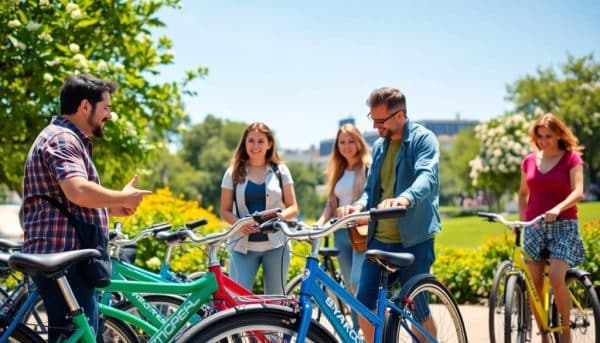Cycling can be an exhilarating way to explore new places, stay fit, and save money. However, if you’re not careful, it’s easy to fall into some common traps when hiring a bike. Understanding how to avoid common bike hire mistakes can make your cycling experience far more enjoyable.
In this article, we will delve into the essential aspects of bike hire, from preparation to planning your route, ensuring you have the right tools for repairs, and maintaining bike security. By the end, you will be well-equipped to ride with confidence and pleasure.
How can I prepare for a cycling commute?
Preparing for a smooth cycling commute is paramount for a stress-free experience. Start by considering your route and timing. You should aim to leave a little earlier, allowing for unexpected delays.
Another vital aspect is ensuring that your bike is in top condition. Check the brakes, tires, and gears before heading out. Regular maintenance can prevent breakdowns and enhance your cycling experience.
Additionally, wear appropriate clothing for the weather conditions. Layers are recommended, as they can be adjusted based on changing temperatures. Lastly, stay hydrated and consider packing a small snack to keep your energy levels high.
What essential tools should I carry for bike repairs?
When cycling, having the right tools for roadside repairs can be a lifesaver. Essential tools for roadside repairs while biking include:
- Multi-tool: A compact option with various functions can address minor mechanical issues.
- Spare inner tube: Flats can happen unexpectedly; having a spare can save you time.
- Bike pump: Keeping your tires inflated is crucial for safety and performance.
- Patch kit: Great for quick fixes in case you don’t have a spare tube.
Being prepared with these essential tools can help you tackle unexpected issues without too much stress. Remember that practice makes perfect; knowing how to use these tools will boost your confidence.
How do I plan a safe cycling route?
Planning a safe cycling route is not only about choosing the shortest path. You should also consider traffic patterns and road types. Tips for planning a safe cycling route include:
- Use cycling apps like Google Maps or Strava to find bike-friendly paths.
- Avoid busy streets where possible; look for dedicated bike lanes.
- Familiarize yourself with local cycling laws and regulations to stay compliant.
Additionally, explore your route ahead of time if possible. This helps you identify potential hazards and allows you to adjust your path accordingly. Always stay alert, especially at intersections and during heavy traffic.
What are the best practices for bike security?
Bike theft is a significant concern for cyclists, but you can take steps to minimize this risk. Best practices for securing your bike against theft include:
- Invest in a high-quality lock: A U-lock is generally considered more secure than a cable lock.
- Lock the frame and both wheels to a solid object.
- When possible, park your bike in well-lit, busy areas.
- Remove any accessories that can be easily detached.
Being proactive about bike security can save you from the distress of theft and ensure your bike is there when you return.
How can I ensure my bike is ready for winter?
Preparing for winter cycling involves more than just dressing warmly. Ensuring that your bike is ready for winter means addressing special maintenance needs. For instance, consider switching to winter tires that offer better traction on slippery surfaces.
You should also keep your bike clean and dry to prevent rust and corrosion. Regularly lubricate the chain and gears to ensure smooth operation. Charging your lights is particularly important during the shorter days of winter.
Lastly, consider investing in warm gear such as gloves and thermal layers, which can make a substantial difference in comfort during chilly rides.
What should I pack for a long-distance cycling trip?
Packing adequately for a long-distance cycling trip can make or break your adventure. Here’s a list of essential items to consider:
- Water bottles: Hydration is key during long rides.
- Snacks: High-energy foods like nuts and energy bars will help maintain your stamina.
- First aid kit: Always be prepared for minor injuries.
- Weather gear: A lightweight rain jacket can be helpful in case of unexpected showers.
Long-distance cycling can be a test of endurance. Being well-prepared ensures you can focus on the ride rather than on what you forgot at home.
What common nutrition mistakes should I avoid while cycling?
Maintaining proper nutrition is crucial for cyclists. Common nutrition mistakes for cyclists often include forgetting to hydrate adequately. Dehydration can severely impact performance, especially during long rides.
Additionally, consuming too few calories can lead to fatigue. It’s advisable to eat small, frequent meals and snacks to keep energy levels stable. Balancing carbohydrates, proteins, and fats is also essential for optimal energy use.
Finally, avoid trying new foods just before or during a ride. Stick to what your body is used to in order to prevent any digestive issues while on the go.
Frequently asked questions about bike hire mistakes
What is the 75 rule in cycling?
The 75 rule in cycling suggests that cyclists should aim to maintain a heart rate that is 75% of their maximum during rides. This moderate intensity level helps optimize cardiovascular benefits while still allowing for conversation and enjoyment during the ride. It is a great guideline for ensuring you gain maximum health benefits without overexerting yourself.
What is the rule 67 for cycling?
Rule 67 refers to the guideline stating that cyclists should always be aware of their surroundings and to ride with both hands on the handlebars unless signaling. This rule emphasizes safety and control, encouraging cyclists to maintain a stable position while navigating through traffic or other obstacles.
What is the N-1 rule for bikes?
The N-1 rule suggests that for every bike you own, you should have one fewer bike than you need for a particular ride. This rule helps ensure that your collection is manageable and that each bike serves a specific purpose, whether for commuting, racing, or leisure. It encourages cyclists to think critically about their cycling needs and make informed decisions regarding their bike choices.
What color bike is least likely to be stolen?
Research suggests that bikes in unique or bright colors are less likely to be stolen compared to standard colors like black or silver. Thieves often prefer to target bikes that blend in with the surroundings. Therefore, if you want to deter theft, consider opting for a vibrant color that stands out, making it easier to spot if stolen.


Leave a Reply